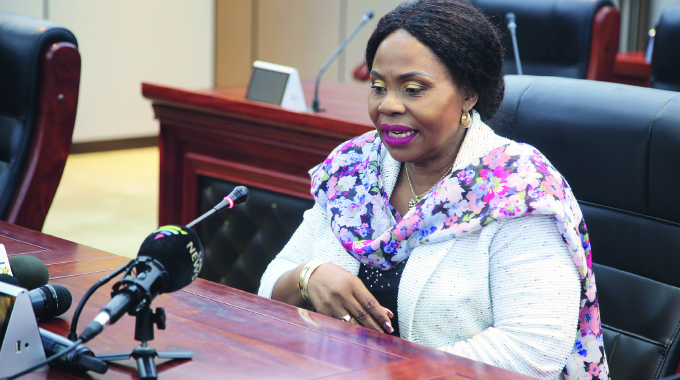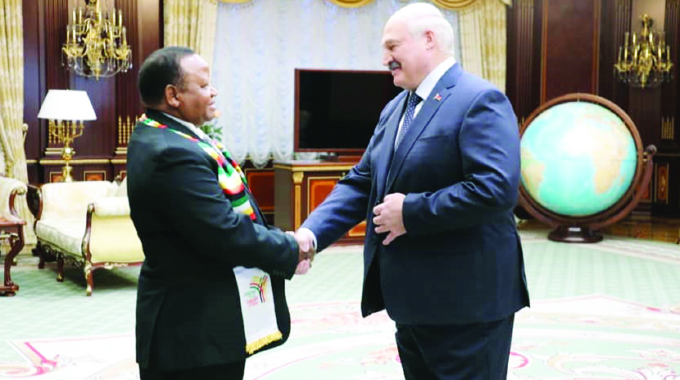Journey towards uplifting livelihoods on firm path through plethora of projects

Cabinet received and noted the Compendium of Projects implemented by the Second Republic during the period 2018 to 2022 presented by the Minister of State for Presidential Affairs and Monitoring Implementation of Government Programmes, Hon Joram Gumbo. The purpose of the compendium of both Government and private sector-funded projects is to inform stakeholders and the public of the work that the Second Republic is undertaking in uplifting the livelihoods of citizens as we journey towards a prosperous and empowered upper middle-income society by 2030.
The intention of the compendium is to:
- Inform the citizenry on the status of life-changing projects meant to address the needs and problems of the generality of the people;
- Promote the participation of citizens in national development issues, which is consistent with the devolution and decentralisation agenda; and
iii. Serve as a referral source document for tracking project implementation and performance.
The nation is being advised that a total of 6 869 projects were implemented across the country’s ten provinces, 4 984 of which were completed. The highest number of completed projects were under infrastructure, with 1 866 which constitute 37.4 percent of the projects. The highest number of projects were implemented in the following provinces, namely: Midlands, 1 083; Manicaland, 951; Mashonaland East, 861 and Matabeleland South, 800.
The summary of the projects implementation nationwide is as follows:
- Bulawayo Metropolitan Province had 230 projects, out of which 163 were completed and 67 are soon to be completed. Among the completed projects are the following:
- A new plant at Treger Group (Kango) was installed and is now operational;
- A soft drink plant was installed at Arenel (Pvt) Ltd;
- Digital TV transmission equipment was installed at ZBC’s Montrose studio;
- The rehabilitated Thorngroove Infectious Diseases Hospital;
- 10 Community Information Centres were established;
- 5 ECD blocks were completed at 5 primary schools which are Nketa, Mahatshula, Mganwini, Manundwane and Senzangakhona; and
- 5 roads were tarred-6th Avenue, 8th Avenue, Coghlan Ave, Doncaster Road and Woodville Park Road.
- Harare Metropolitan Province had 267, with 121 completed projects and 146 soon to be completed. Those completed include:
- A Youth Interaction Centre which was established in Mufakose;
- 22,4 kilometres of road were tarred;
- E-Passport offices were established and operationalised;
- A gender response safe market was established in Epworth; and
- 30 Community Information Centres were established in the province.
- Manicaland Province had a total of 951 projects, with 777 completed and 174 soon to be completed. The completed projects include the following:
- The construction of Marovanyati dam;
- Construction of washed away bridges and approaches on nine bridges affected by Cyclone Idai;
- 10 ICT labs were established across the Province;
- 147 schools were connected to the internet;
- 281 SMEs were funded;
- Establishment of a saw milling plant at Cashel Valley; and
- 14 health centres were connected to the digital platform.
- Mashonaland Central Province had 727, with 581 completed and 146 soon to be completed. Some of the projects that were completed and functional include:
- 13 Rural Health Centres;
- 5 Piped Water Schemes were established at Chahwanda, Bveke, Kaitano, Kamutsenzere and Chigango in Mt. Darwin;
- The Eureka Gold Mine in Guruve was resuscitated and now functional;
- 123 ICT Labs were established and equipped;
- 50 boreholes were drilled and 300 others rehabilitated; and
- Karanda Bridge was constructed and commissioned.
- Mashonaland East Province had a total of 861, out of which 604 were completed and 257 soon to be completed. Those completed include the following:
- Radnor Gold Mine in Mudzi;
- Mutoko Fruit and Vegetable Processing and Packing Hub;
- A US$400 000 egg tray making plant in Marondera; and
- Construction of Science Laboratories at Chitimbe, Morris, Magunje, Chikuhwa, Borera, Dindi, Rudawiro, Mugabe, Chidodo and Musanhi Secondary Schools.
- Mashonaland West Province had 604 projects, with 452 projects completed and 152 soon to be completed. Among those completed are:
- Establishment of e-passport offices in Chinhoyi;
- Construction of an Innovation Hub at Chinhoyi University of Technology;
- Establishment of the Chinhoyi One-Stop-Centre;
- The installation of an oil refinery plant at Agri-Value Chain in Chegutu; and
- The renewal of the Mutorashanga FM Transmitter.
- Masvingo Province had 677 projects, with 537 completed and 140 soon to be completed. The completed projects include:
- Rehabilitation of Chambuta Multi-purpose Sports Complex in Chiredzi;
- Preservation of Kamungoma Massacre Monument where a memorial and ablution facilities constructed;
- Rehabilitation of 85 kilometres of the Ngundu-Tanganda Road; and
- Drilling of 44 boreholes in Bikita, Masvingo, Chivi, Chiredzi and Mwenezi Districts.
- Matabeleland North Province had 669, with 435 projects completed and 234 soon to be completed. The completed projects include:
- The establishment of Hwange Teachers College and Binga Vocational Training Centre;
- Installation of Piped Water Schemes at Mkhombo, Jotsholo Sub Office, Dingani Clinic and Tiki Clinic in Lupane and Hwange;
- Construction of the Lupane Magistrates Court; and
- Installation of a transmitter at Lupane State University campus.
- Issuance of National Registration documents in Tsholotsho and Binga, and availing of employment opportunities in Government Departments.
- Matabeleland South Province had 800 projects, with 523 completed and 277 soon to be completed. Those completed include:
- Launch of the Ntepe-Manama community radio station;
- Rolling out of the Water, Sanitation and Hygiene (WASH) Schools Project;
- The establishment of the mopani worm/ amacimbi/madora processing plant at Beitbridge; and
- The 5MW Richsaw Solar Plant at Gwanda.
- Midlands Province had 1 083 projects, with 791 completed and 292 are soon to be completed. Those completed include:
- Construction of the RZM Murowa 500TPH Greenfields Diamond Plant;
- 300 Primary Health Centres were installed with 8KVA solar panels;
- The Midlands State University National Language Centre;
- Renewal of the Gweru FM transmitter; and
- 535 women were funded under the Women Development Fund.
The Compendium will be translated into the 16 recognised languages of Zimbabwe. These projects have improved peoples lives across Zimbabwe’s provinces. They have also enhanced access to Water Sanitation and Hygiene facilities, Irrigation programmes, access to radio, television and markets for their various products and availed business opportunities to the youth, women and SMEs.
ZIMBABWE’s RESPONSE TO THE Covid-19 PANDEMIC, AND REPORT ON THE PROCUREMENT AND ROLLOUT OF VACCINES
Cabinet received an update on the Country‘s Response to the Covid-19 Pandemic, and a Report on the Procurement and Roll-Out of Vaccines, as presented by the Chairman of the Ministers’ Committee on the National Covid-19 response, Honourable Vice President and Minister of Health and Child Care, Gen (Rtd) Dr CGDN Chiwenga.
The nation is being informed that the cumulative Covid-19 cases as at 26 March, 2023 stood at 264 511, with 258 720 recoveries and 5 679 deaths. There were 112 active cases. No new deaths were recorded during the week under review. There were ten new admissions, compared to the seventeen recorded the previous week, with two being in intensive care.
Regarding the national vaccination programme, a total of 6 915 115 first doses of the Covid-19 vaccine, 5 132 220 and 1 691 432 second and third doses have so far been administered. Provincial Task Force teams will continue strengthening implementation of all Covid-19 public health and social measures, with focus on the vaccination programme.
NATIONAL TECHNICAL AND VOCATIONAL EDUCATION AND TRAINING POLICY
Cabinet was briefed by the Minister of Higher and Tertiary Education, Innovation, Science and Technology Development Honourable Prof A Murwira, as chairman of the Cabinet Committee on Human Capital Development, Skills Audit and Employment Creation, on the Zimbabwe National Technical and Vocational Education and Training (TVET) policy. Cabinet approved the all-encompassing policy which will harmonise and standardise the coordination of TVET across line Ministries. Presently, the coordination of TVET is fragmented throughout 10)Ministries.
As the nation may recall, the Second Republic is on a trajectory to transform the education system from the traditional Education 3.0 model which prioritised teaching, research and community service to one that puts emphasis on teaching, research, community service, innovation and industrialisation and is termed Heritage-based Education 5.0.
This model is grounded on production of goods and services, thereby creating entrepreneurs for the industrialisation and modernisation of Zimbabwe.
The policy seeks to align education and skills training in order to promote wealth creation and entrepreneurship opportunities. The thrust of the Second Republic is that all learning in tertiary institutions shall be for the purpose of advancing national development.
The TVET policy is anchored on the following pillars:
- Reconfiguring and strengthening programme infrastructure;
- Strengthening human capital infrastructure;
iii. Developing and maintaining physical and digital infrastructure;
- Strengthening the legal infrastructure; and
- Facilitating the deployment of innovative financing infrastructure.
It is envisaged that the implementation of the National TVET Policy will culminate in the realisation of the following benefits:
- A centrally coordinated and regulated TVET qualifications system;
- Harmonised and standardised qualifications, in line with the Heritage-Based Education 5.0 Model;
iii. Guaranteed horizontal portability and vertical articulation of qualifications across line Ministries;
- Improved quality of TVET across Ministries, in line with the country’s Vision 2030;
Economies of scale and scope in production of TVET graduates; and
- Enhanced industrial productivity and competitiveness of the graduates, in line with Vision 2030.
The national is further being informed that the Technical Vocational Education Training Policy will apply to all Government-owned or private institutions which offer technical and vocational education. The operations of these institutions are regulated by the Manpower Planning and Development Act. Government appreciates the role being played by the private sector towards provision of technical and vocational education through financial contributions to the Zimbabwe Manpower Development Fund (ZIMDEF).
Government will come up with an inclusive and sustainable financing model on grants and loans to TVET institutions by Government itself, Banks, Pension Funds and the Zimbabwe Manpower Development Fund. Government will introduce a Work-for–Fees Programme in all TVET institutions to alleviate the plight of students from vulnerable backgrounds, and establish hybrid companies that commercialise TVET innovation products and services. Manuals for various trades will be developed, including in all the national languages, in order to enhance opportunities for training for students from diverse backgrounds.
REPORT ON THE NATIONAL CHOLERA RESPONSE AS AT 28th MARCH, 2023
Cabinet considered the Report on the National Cholera Response as at 28th March 2023, which was presented by the Honourable Vice President and Minister of Health and Child Care, Gen. (Rtd.) C.G.D.N. Chiwenga.
Cabinet wishes to inform the nation that cholera outbreaks on the African continent are occurring in the context of cyclones, floods, conflicts, poor sanitation and unreliable water supplies. Cross-border mobility also plays a part in the spread of cholera and other diseases. So far, thirteen (13) African countries have reported cholera outbreaks. South Africa, Tanzania, Zambia and Zimbabwe recently reported cholera outbreaks in 2023. Despite the cases reported in Zimbabwe, the case fatality rate is still low. Zimbabwe’s cumulative suspected cholera cases stood at 231, with 209 recoveries and 2 deaths. Out of the country’s ten provinces, only Matabeleland North and Midlands have so far not reported any cholera cases.
Cabinet wishes to assure the nation that the cholera situation is under control. Active screening at ports of entry and exit has been initiated, and surveillance activities are ongoing. Cabinet approved a total budget of US$ 24 168 353 for the cholera epidemic preparedness and response plan. Several partners including the World Health Organisation, the Centre for Disease Control, UNICEF, Medicines sans Frontiers and Higher Life Foundation have pledged to support part of the budget.
Cabinet is informing the Public that Ministers of State for Provincial Affairs and Devolution and their teams have been argued to continue to support activities to fight the cholera outbreak. Community and political leaders are also expected to lend maximum support to the anti-cholera programme through awareness activities.
REPORT ON THE SADC COUNCIL OF MINISTERS MEETING
Cabinet received a report on the SADC Council of Ministers Meeting held in Kinshasa, DRC on 18th – 19th March, 2023, which was presented by Honourable Prof. A. Murwira, the Minister of Higher and Tertiary Education, Innovation, Science and Technology Development as the Acting Minister of Foreign Affairs and International Trade.
Cabinet is informing the nation that the Council of Ministers Meeting reviewed progress on the implementation of decisions taken in March and August 2022. The Meeting approved various prioritized development projects under the Region’s development blueprint, the Regional Indicative Strategic Development Plan (RISDP). The approved priority projects which Zimbabwe will directly benefit from include the UNIVISA Pilot Project which will allow SADC citizens to travel seamlessly within the SADC Region; the SADC Regional Water Supply and Sanitation Programme which involves delivery of cross-border water supply and sanitation infrastructure; and a programme promoting a competitive, inclusive and sustainable leather sector in Tanzania and Zimbabwe. The Meeting took note of the Status of Disasters in the SADC Region and expressed concern over climate-related disasters affecting Member States. In particular, Council expressed its condolences to the Republics of Mauritius, Madagascar, Malawi, Mozambique and Zimbabwe for the loss of life and damage to infrastructure and flooding caused by Tropical Cyclone Freddy. In this regard, Council noted the urgent need to operationalise the SADC Humanitarian and Emergency Operations Centre, based in Nacala, Nampula Province in Mozambique, in order for the region to be better able to coordinate rapid humanitarian interventions in the face of natural disasters.
The Council of Ministers also considered issues to do with access to and supply of sustainable power in the Region. In particular, Council expressed concern over the slow implementation of various Regional inter-connector projects, despite the completion of technical feasibility studies. Among these are the Zimbabwe – Zambia – Botswana – Namibia (ZIZABONA) inter-connector project and the Alaska – Sherwood project which is part of the Central Transmission Corridor. These projects were also identified as priority regional development programmes under the region’s economic blueprint, the Regional Indicative Strategic Development Plan.
UPDATE ON THE RELIEF PACKAGE FOR MALAWI
Cabinet received a brief report on the relief package prepared by Zimbabwe for assisting Malawi in the aftermath of Cyclone Freddy, which was presented by the Minister of Local Government and Public Works, Honourable J.G. Moyo.
Pursuant to the appeal by Cabinet to the private sector for donations towards the Malawi cause, Cabinet is informing the nation that the private sector responded positively at a function that was held on Monday, 27 March 2023 at State House. Donations in kind are being delivered to a warehouse run by the Civil Protection Unit, while cash donations are being received by the Ministry of Finance and Economic Development which has opened a special account dedicated for that purpose. Pledges for more assistance were received. Meanwhile, the initial donation incorporating 300 metric tonnes of mealie-meal among other products, has since been received in Malawi.
Cabinet would like to express profound gratitude to the private sector whose members have and are continuing to donate generously towards this worthy cause.








Comments